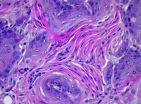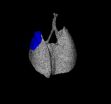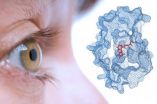(Press-News.org) Only 15% of patients with squamous cell lung cancer – the second most common lung cancer – survive five years past diagnosis. Little is understood about how the deadly disease arises, preventing development of targeted therapies that could serve as a second line of defense once standard chemotherapy regimens fail.
Published online in Cell Reports on June 19, Huntsman Cancer Institute investigators report that misregulation of two genes, sox2 and lkb1, drives squamous cell lung cancer in mice. The discovery uncovers new treatment strategies, and provides a clinically relevant mouse model in which to test them.
"This is the most exciting thing we've done," said senior author Trudy Oliver, Ph.D., an assistant professor of oncological sciences at the University of Utah and Huntsman Cancer Institute investigator. "Now that we have a model it unleashes so many questions we can ask to gain a better understanding of the disease."
By definition, tumors are groups of cells that are out of control. As a result, they acquire mutations, only some of which drive properties – such as excess growth and motility - that make cells cancerous. The trick for developing targeted therapies is to distinguish the "driver" from "passenger" mutations that are merely along for the ride.
Call it guilt by association, but Oliver's team honed in on drivers of squamous cell carcinoma (SCC) of the lung by poring through documented gene abnormalities found in human SCCs. Sox2 was designated a prime candidate based on its overexpression in 60-90% of SCCs, and a frequent early appearance during tumor formation, suggesting it could be an initiator of cancer. Tumor suppressor genes were also candidates, including Lkb1, which is mutated in 5-19% of SCCs.
While disruption of either gene alone failed to trigger cancer, combining overexpression of sox2 in the lung with loss of lkb1 led to frequent development of lung SCC in mice.
"A pathologist looking under the microscope at our tumors would not know it's from the mouse," said Oliver. "They visually look like human tumors, and then when we stain them for biomarkers of the human disease, our mouse tumors light up for those markers."
Unlike most previously existing lung SCC mouse models that develop multiple tumor types, the sox2/lkb1 model generates SCC exclusively. Combine this with the fact that it was created based on patient data makes the model clinically relevant, and well poised for testing novel targeted therapies.
"Beyond lung cancer, findings from this model may have important clinical implications for other squamous or Sox2-driven malignancies such as small cell lung cancer, and brain, esophageal, and oral cancers," said Anandaroop Mukhopadhyay, Ph.D., Huntsman Cancer Institute scientist and lead author on the paper.
While there are no known drugs that directly target either Sox2 or Lkb1,
there are existing therapies that interfere with biochemical pathways that are thought to be activated by these genes. What's more, the scientists found that these pathways, Jak-Stat and mTOR, were activated in tumors in the new mouse model. These findings suggest that the drugs that block these pathways, STAT3 and mTOR inhibitors, are good candidates for working as lung SCC targeted therapies.
"These are pathways that had not been previously explored for the treatment of squamous tumors because we didn't realize they were important," Oliver explained. "That gives us direction for testing the efficacy of drugs aimed at these pathways."
INFORMATION:
Listen to an interview with Trudy Oliver about creation of the sox2/lkb1 mouse model on The Scope Radio
http://healthcare.utah.edu/the-scope/shows.php?shows=0_y8w0ys9x
Mukhopadhyay, K.C. Berrett, U. Kc, P.M. Clair, S.M. Pop, S.R. Carr, B.L. Witt, T.G. Oliver (2014) Sox2 cooperates with Lkb1 loss in a mouse model of squamous cell lung cancer. Cell Reports published online ahead of print, June 19, 2014
http://www.cell.com/cell-reports/abstract/S2211-1247%2814%2900430-6
This work was supported by DoD USAMRAA W81XWH-12-1-0211, The V Foundation for Cancer Research, Huntsman Cancer Foundation., and Damon Runyon Cancer Research Foundation
About Huntsman Cancer Institute at the University of Utah:
Huntsman Cancer Institute (HCI) is one of the world's top academic research and cancer treatment centers. HCI manages the Utah Population Database - the largest genetic database in the world, with more than 16 million records linked to genealogies, health records, and vital statistics. Using this data, HCI researchers have identified cancer-causing genes, including the genes responsible for melanoma, colon and breast cancer, and paraganglioma. HCI is a member of the National Comprehensive Cancer Network (a 25-member alliance of the world's leading cancer centers) and is a National Cancer Institute-Designated Cancer Center. HCI treats patients with all forms of cancer and operates several high-risk clinics that focus on melanoma and breast, colon, and pancreas cancers. The HCI Cancer Learning Center for patient and public education contains one of the nation's largest collections of cancer-related publications. The institute is named after Jon M. Huntsman, Sr., a Utah philanthropist, industrialist, and cancer survivor.
A new tool to confront lung cancer
Huntsman Cancer Institute investigators develop clinically relevant mouse model for difficult-to-treat squamous cell lung cancer
2014-06-19
ELSE PRESS RELEASES FROM THIS DATE:
A better imager for identifying tumors
2014-06-19
WASHINGTON, June 19, 2014—Before they excise a tumor, surgeons need to determine exactly where the cancerous cells lie. Now, research published today in The Optical Society's (OSA) journal Optics Letters details a new technique that could give surgeons cheaper and more lightweight tools, such as goggles or hand-held devices, to identify tumors in real time in the operating room.
The new technology, developed by a team at the University of Arizona and Washington University in St. Louis, is a dual-mode imager that combines two systems—near-infrared fluorescent imaging to ...
Swiftly moving gas streamer eclipses supermassive black hole
2014-06-19
Astronomers have discovered strange and unexpected behaviour around the supermassive black hole at the heart of the galaxy NGC 5548. The international team of researchers detected a clumpy gas stream flowing quickly outwards and blocking 90 percent of the X-rays emitted by the black hole. This activity could provide insights into how supermassive black holes interact with their host galaxies.
The discovery of the unusual behaviour in NGC 5548 is the result of an intensive observing campaign using major ESA and NASA space observatories, including the NASA/ESA Hubble Space ...
LLNL, MIT researchers develop new ultralight, ultrastiff 3D printed materials
2014-06-19
LIVERMORE, Calif. – Imagine a material with the same weight and density as aerogel -- a material so light it's called 'frozen smoke' -- but with 10,000 times more stiffness. This material could have a profound impact on the aerospace and automotive industries as well as other applications where lightweight, high-stiffness and high-strength materials are needed.
Lawrence Livermore and Massachusetts Institute of Technology (MIT) researchers have developed a material with these properties using additive micro-manufacturing processes. The research team's findings are published ...
Kids with strong bonds to parents make better friends, can adapt in relationships
2014-06-19
URBANA, Ill. – What social skills does a three-year-old bring to interactions with a new peer partner? If he has strong bonds to his parents, the child is likely to be a positive, responsive playmate, and he'll be able to adapt to a difficult peer by asserting his needs, according to a new University of Illinois study published in Developmental Psychology.
"Securely attached children are more responsive to suggestions or requests made by a new peer partner. A child who has experienced a secure attachment relationship with caregivers is likely to come into a new peer relationship ...
Mechanism discovered for attaching an 'on' switch that helps cells accessorize proteins
2014-06-19
(MEMPHIS, Tenn. – June 19, 2014) St. Jude Children's Research Hospital scientists have discovered how an important "on" switch is attached to the machinery that cells rely on to adapt thousands of proteins to meet changing conditions. The research appears in the current issue of the journal Cell.
The switch is a small protein called NEDD8. Problems with NEDD8 have been associated with several cancers, developmental disorders and infectivity of the human immunodeficiency virus (HIV), which causes AIDS. Drugs that target NEDD8 are in anti-cancer clinical trials. The ability ...
Drug shows promise for the first time against metastatic melanoma of the eye
2014-06-19
NEW YORK, NY (June 19, 2014) — For the first time, a therapy has been found that can delay progression of metastatic uveal melanoma, a rare and deadly form of melanoma of the eye.
Results from a multicenter clinical trial show that a new drug called selumetinib increases progression-free survival, the length of time during and after treatment that a patient with metastases lives with the disease without it progressing. The findings were published today in the online edition of JAMA, the Journal of the American Medical Association.
"Although the effects of the drug were ...
RNA aptamers targeted to plasminogen activator inhibitor
2014-06-19
New Rochelle, NY, June 19, 2014—Plasminogen activators are proteins involved in the breakdown of blood clots, and an elevated level of plasminogen activator inhibitor-1 (PAI-1) is associated with an increased risk for clotting and cardiovascular disease. No PAI-1 inhibitors are currently available for clinical use, but a novel therapeutic approach using a targeted RNA aptamer drug that has been shown to block PAI-1 activity and prevent PAI-1-associated vascular events is described in Nucleic Acid Therapeutics, a peer-reviewed journal from Nucleic Acid Therapeutics. The ...
Humans & monkeys of one mind when it comes to changing it
2014-06-19
Covert changes of mind can be discovered by tracking neural activity when subjects make decisions, researchers from New York University and Stanford University have found. Their results, which appear in the journal Current Biology, offer new insights into how we make decisions and point to innovative ways to study this process in the future.
"The methods used in this study allowed us to see the idiosyncratic nature of decision making that was inaccessible before," explains Roozbeh Kiani, an assistant professor in NYU's Center for Neural Science and the study's lead author. ...
Scientists identify link between stem cell regulation and the development of lung cancer
2014-06-19
UCLA researchers led by Dr. Brigitte Gomperts have discovered the inner workings of the process thought to be the first stage in the development of lung cancer. Their study explains how factors that regulate the growth of adult stem cells that repair tissue in the lungs can lead to the formation of precancerous lesions.
Findings from the three-year study could eventually lead to new personalized treatments for lung cancer, which is responsible for an estimated 29 percent of U.S. cancer deaths, making it the deadliest form of the disease.
The study was published online ...
Evolution of equine influenza led to canine offshoot which could mix with human influenza
2014-06-19
Equine influenza viruses from the early 2000s can easily infect the respiratory tracts of dogs, while those from the 1960s are only barely able to, according to research published ahead of print in the Journal of Virology. The research also suggests that canine and human influenza viruses can mix, and generate new influenza viruses.
Canine influenza is a relatively new disease. The first appearance is believed to be in 2003, as a result of direct transfer of a single equine influenza virus to dogs in a large greyhound training facility and was subsequently carried to ...
LAST 30 PRESS RELEASES:
New software sheds light on cancer’s hidden genetic networks
UT Health San Antonio awarded $3 million in CPRIT grants to bolster cancer research and prevention efforts in South Texas
Third symposium spotlights global challenge of new contaminants in China’s fight against pollution
From straw to soil harmony: International team reveals how biochar supercharges carbon-smart farming
Myeloma: How AI is redrawing the map of cancer care
Manhattan E. Charurat, Ph.D., MHS invested as the Homer and Martha Gudelsky Distinguished Professor in Medicine at the University of Maryland School of Medicine
Insilico Medicine’s Pharma.AI Q4 Winter Launch Recap: Revolutionizing drug discovery with cutting-edge AI innovations, accelerating the path to pharmaceutical superintelligence
Nanoplastics have diet-dependent impacts on digestive system health
Brain neuron death occurs throughout life and increases with age, a natural human protein drug may halt neuron death in Alzheimer’s disease
SPIE and CLP announce the recipients of the 2025 Advanced Photonics Young Innovator Award
Lessons from the Caldor Fire’s Christmas Valley ‘Miracle’
Ant societies rose by trading individual protection for collective power
Research reveals how ancient viral DNA shapes early embryonic development
A molecular gatekeeper that controls protein synthesis
New ‘cloaking device’ concept to shield sensitive tech from magnetic fields
Researchers show impact of mountain building and climate change on alpine biodiversity
Study models the transition from Neanderthals to modern humans in Europe
University of Phoenix College of Doctoral Studies releases white paper on AI-driven skilling to reduce burnout and restore worker autonomy
AIs fail at the game of visual “telephone”
The levers for a sustainable food system
Potential changes in US homelessness by ending federal support for housing first programs
Vulnerability of large language models to prompt injection when providing medical advice
Researchers develop new system for high-energy-density, long-life, multi-electron transfer bromine-based flow batteries
Ending federal support for housing first programs could increase U.S. homelessness by 5% in one year, new JAMA study finds
New research uncovers molecular ‘safety switch’ shielding cancers from immune attack
Bacteria resisting viral infection can still sink carbon to ocean floor
Younger biological age may increase depression risk in older women during COVID-19
Bharat Innovates 2026 National Basecamp Showcases India’s Most Promising Deep-Tech Ventures
Here’s what determines whether your income level rises or falls
SCIE indexation achievement: Celebrate with Space: Science & Technology
[Press-News.org] A new tool to confront lung cancerHuntsman Cancer Institute investigators develop clinically relevant mouse model for difficult-to-treat squamous cell lung cancer





